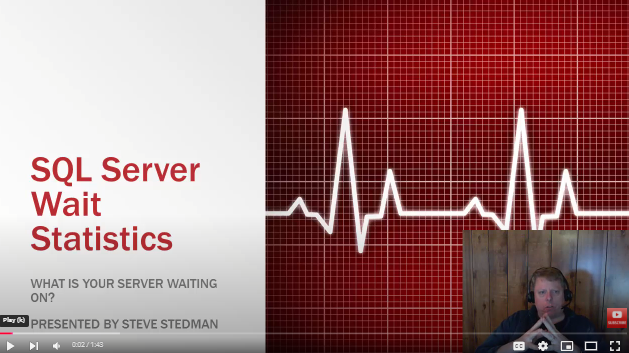Wait statistics, in the context of SQL Server, refer to the amount of time that a query spends waiting to access data in the database. When a client application requests data from the database, the request is placed in a queue and the client application must wait for its turn to access the data. The time that the query spends waiting is called a "wait" and is tracked by SQL Server. This information can be used to identify potential performance bottlenecks and optimize the performance of the database. Wait statistics are commonly used by database administrators to diagnose and troubleshoot performance issues in SQL Server.
The CXPACKET wait type has long been a key indicator of parallelism-related activity in SQL Server. While often misunderstood, it is essential to recognize that CXPACKET is not always a sign of a problem. Instead, it indicates synchronization waits during parallel query execution. Properly interpreting and managing this wait type is crucial for optimizing SQL Server performance.
What Is the CXPACKET Wait Type?
The CXPACKET wait type represents waits that occur when SQL Server threads need to synchronize during parallel query execution. When a query runs with a parallel plan, SQL Server splits the workload into multiple tasks distributed across threads. These threads may wait for each other at various synchronization points, and this wait time is categorized as CXPACKET.
The Evolution of CXPACKET
Historically, CXPACKET was a catch-all wait type for parallel query execution. However, with the introduction of CXCONSUMER in SQL Server 2016 SP2 and SQL Server 2017 CU3, much of the actual parallel work is now tracked under CXCONSUMER. This change leaves CXPACKET primarily as a measure of thread synchronization waits, providing clearer insights into parallelism overhead.
Common Causes of CXPACKET Waits
While CXPACKET is a normal part of parallel query execution, excessive waits can indicate inefficiencies. Common causes include:
1. Imbalanced Workload Distribution
If parallel threads are not evenly distributed with work, some threads finish earlier and must wait for others. This imbalance leads to CXPACKET waits.
2. Suboptimal MAXDOP Settings
The MAXDOP (Maximum Degree of Parallelism) setting controls how many threads SQL Server uses for parallel execution. If set too high, excessive thread usage can cause synchronization overhead.
3. Inappropriate Cost Threshold for Parallelism
SQL Server decides whether to use parallelism based on the query’s estimated cost. The default Cost Threshold
for Parallelism value of 5 is often too low, causing unnecessary parallel plans for lightweight queries.
4. Skewed Data Distribution
Skewed or uneven data distribution in joins, groupings, or aggregations can cause some threads to do more work than others, leading to CXPACKET waits.
5. Resource Contention
Limited CPU or memory resources can exacerbate synchronization waits during parallel query execution.
How to Diagnose and Optimize CXPACKET Waits
Resolving CXPACKET waits involves analyzing your workload and tuning your SQL Server environment. Follow these steps:
1. Monitor Wait Statistics
Use Database Health Monitor or SQL Server DMVs like sys.dm_os_wait_stats
to track CXPACKET and related wait types. Look for patterns indicating excessive parallelism.
2. Review Query Execution Plans
Query execution plans provide insights into parallelism usage. Focus on:
- Operators like
HASH JOINorGROUP BYthat contribute to parallel plans. - Skewed parallel operations where some threads handle significantly more data than others.
3. Adjust MAXDOP Settings
Configure MAXDOP to balance performance and synchronization overhead. For OLTP workloads, values
like 4 or 8 are common. Use sp_configure or database-scoped configurations to adjust this setting:
EXEC sp_configure 'max degree of parallelism', 4;
RECONFIGURE;
4. Increase Cost Threshold for Parallelism
Raise the Cost Threshold for Parallelism to prevent parallel execution for low-cost queries. A value of
30 or higher is often appropriate for OLTP workloads. Use sp_configure to adjust:
EXEC sp_configure 'cost threshold for parallelism', 30;
RECONFIGURE;
5. Optimize Query and Index Design
Rewrite problematic queries to minimize parallelism:
- Create or optimize indexes to reduce table scans.
- Address skewed data distribution in joins or aggregations.
- Filter unnecessary data earlier in the query to reduce workload.
6. Evaluate Hardware Resources
Ensure sufficient CPU and memory resources to support parallel workloads. If resource contention is a bottleneck, consider upgrading your hardware or moving to a scalable cloud environment.
Joke
Why did the SQL Server developer bring CXPACKET to the party?
Because it promised to parallelize the fun... but spent the whole night waiting for everyone else to finish their tasks!
Summary
The CXPACKET wait type is a natural part of parallel query execution in SQL Server. While excessive CXPACKET waits can signal inefficiencies, they are not inherently bad. By analyzing execution plans, tuning MAXDOP and Cost Threshold for Parallelism, and optimizing queries, you can minimize unnecessary synchronization overhead and improve performance.
For more in-depth analysis and expert assistance, consider Stedman Solutions SQL Server Managed Services. Our team specializes in performance tuning, monitoring, and query optimization to ensure your SQL Server environment operates at its best. Contact us today to learn more!

Find out more about our SQL Server Managed Services
Applies to
Related Waits
CXCONSUMERCXSYNC_CONSUMER
CXSYNC_PORT
See Also
All Wait Types


